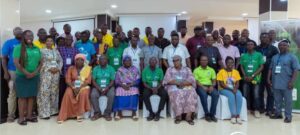Farmers fear losing source of livelihoods over restriction on soyabean export
 More than 100,000 soyabean farmers in northern Ghana fear losing their source of livelihoods if the ban on export of the commodity is not reversed.
More than 100,000 soyabean farmers in northern Ghana fear losing their source of livelihoods if the ban on export of the commodity is not reversed.
Some of the farmers, who expressed worry about the situation, said the decision by the government to place a ban on the export of certain commodities such as rice, maize and soyabeans was having a negative impact on their livelihoods, especially soyabean farmers.
They said such farmers, especially those into soyabean cultivation could not sell their produce after harvest while some had low sales, thereby recording losses and unable to continue farming.
Alhaji Jibiliru Nankpa, a soybean farmer from Pluma, a village in the Sissala East Municipality of the Upper West Region, said apart from the 100,000 farmers, who were directly engaged in the production of soyabeans, many actors in the soyabean value chain were also at risk of losing their livelihoods if government did not reconsider its decision.
Alhaji Nankpa was speaking during an Annual Planning and Review workshop of the Sustainable Soybean Production in Northern Ghana (SSPiNG) project held in Tamale.
The three-day meeting was to review activities implemented under the project in 2023 and come out with strategies to improve implementation moving forward in 2024.
It was attended by various stakeholders, including Deputy Directors from the Ministry of Food and Agriculture, District and Municipal Heads of Department of Agriculture from 16 beneficiary districts and municipalities in northern Ghana, farmers, aggregators, Yara Ghana, International Institute of Tropical Agriculture (IITA) as well as other value chain actors from the five regions of the north.
The SSPiNG project seeks to sustainably increase the production of soybean to meet the rising demand in the country as well as enable rural households to raise their incomes and improve food security on sustainable basis.
It is being implemented by IITA and Yara Ghana in partnership with the MoFA, Wageningen University and Research and Felleskjopet Rojaland Agder in Norway, and funded by the Norwegian Agency for Development Cooperation (NORAD).
In August 2020, the government through a Legislative Instrument, temporarily banned the export of soyabean and maize grains as part of measures to ensure food security and increase local poultry and livestock production.
Alhaji Nanpka said the ban on the export of soyabean grains was a counter-productive measure, which was affecting the incomes of farmers and discouraging them from further investment into the sector despite the huge economic potential.
He said, ‘’Apart from low prices offered by the local processors, the local processors did not have the capacity to buy and yet the government prevented the people from exporting their produce to where they can get market.”
He, however, said the inception of the SSPiNG project had brought some relief to farmers.
“Our biggest challenge in the farming system currently is how to access funds, and fertilizer but we are glad to have met SSPiNG and other partners supporting us with grants and other materials”, he said
Alhaji Nankpa called on the government to lift the restriction on the export of soyabean grains to allow the sector to contribute significantly to restoring the economy and incomes of farmers.
He said, “Our worry is that after the restriction, the local buyers are not reaching out to the farmers to buy and the few who can buy are buying and aggregating for export. So, today, if you go to most of the districts especially in northern sector, farmers, who invested massively in soyabean, cannot sell.”
Professor Samuel Adjei-Nsiah, Coordinator of the SSPiNG project, said the production level of soyabean in Ghana was around 170,000 metric tonnes in 2020 but currently the country was making around 389,000 metric tonnes, which meant about 200,000 metric tonnes had been added to what was produced in 2020.
He said, ‘’I can see that now we are self-sufficient in soyabean production and have the capacity to export but what we are lacking now is the internal capacity to absorb the majority of the grains that we produce. Now, we are exporting more of the raw grains and processing around 120,000 metric tonnes but we have to do more by processing 250,000 tonnes.”
He added that “When we do that, we will add value to the grains that we produce and also be able to process enough for our poultry industry.”
He said the project was currently working with about 150,000 smallholder farmers in the five regions of the north with improved technologies, and supply chain information on weather and market.
Professor Adjei-Nsiah said this was done through demonstrations, community video shows and other knowledge products as well as the use of the Esoko digital platform to deploy weather, market price and agronomic advisory services to the smallholder farmers.
Mr Kudjoe Agbenyega, Chief Finance Officer, YARA Ghana assured the farmers of the availability of fertilizer and other Yara products for the next farming season.
Source: GNA
